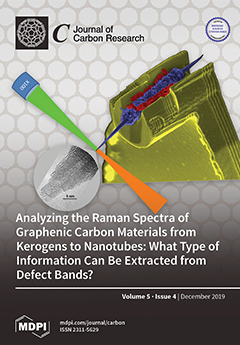Multiwavelength Raman spectroscopy (325, 514, 633 nm) was used to analyze three different kinds of samples containing sp
2 and sp
3 carbons: chemical vapor deposited diamond films of varying microstructure, a plasma-enhanced chemical vapor deposited hydrogenated amorphous carbon film heated at 500
[...] Read more.
Multiwavelength Raman spectroscopy (325, 514, 633 nm) was used to analyze three different kinds of samples containing sp
2 and sp
3 carbons: chemical vapor deposited diamond films of varying microstructure, a plasma-enhanced chemical vapor deposited hydrogenated amorphous carbon film heated at 500 °C and highly oriented pyrolytic graphite exposed to a radio-frequent deuterium plasma. We found evidence that the lower part of the phonon density of states (PDOS) spectral region (300–900 cm
−1) that rises when defects are introduced in crystals can give more information on the structure than expected. For example, the height of the PDOS, taken at 400 cm
−1 and compared to the height of the G band, depends on the sp
2 content, estimated by electron energy-loss spectroscopy. This ratio measured with 633 nm laser is more intense than with 514 nm laser. It is also correlated for diamond to the relative intensity ratio between the diamond band at 1332 cm
−1 and the G band at ≈1500–1600 cm
−1 when using 325 nm laser. Moreover, it is found that the shape of the PDOS of the exposed graphite samples is different when changing the wavelength of the laser used, giving evidence of a double resonance mechanism origin with the rise of the associated D
3, D
4 and D
5 bands, which is not the case for a-C:H samples.
Full article





